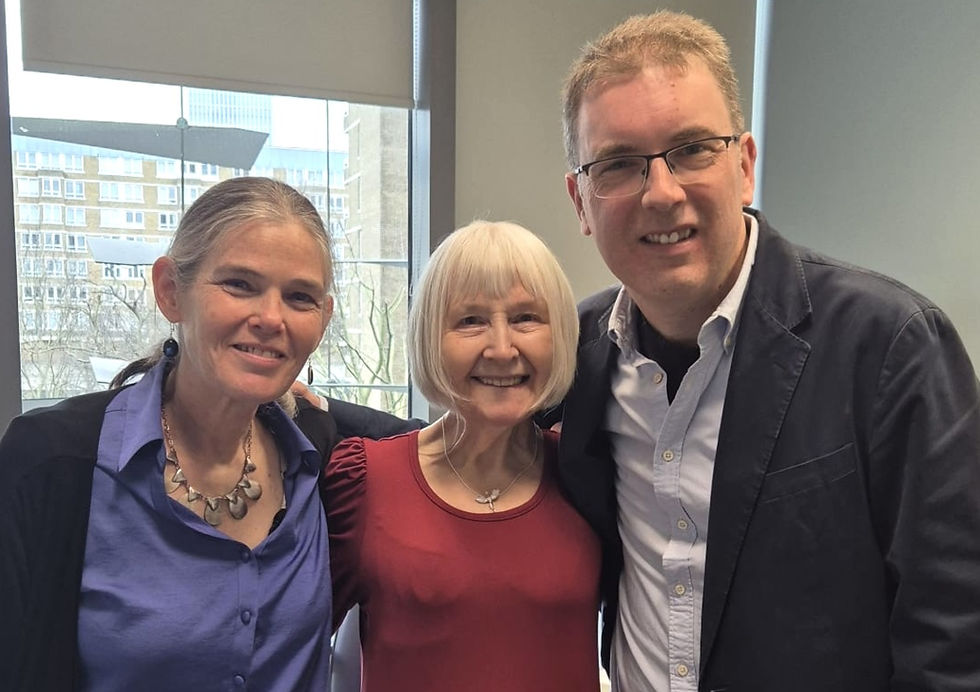Greener AI model costs less to accurately diagnose eye disease
- INSIGHT communications team
- Sep 4, 2025
- 4 min read
In a step forward for sustainable medical artificial intelligence (AI), researchers at Moorfields Eye Hospital NHS Foundation Trust, University College London (UCL) Institute of Ophthalmology, and University of Edinburgh have developed a ‘green’ training approach for medical AI in ophthalmology, requiring far less computing power and data than existing systems.
The novel training method was used to develop a foundation model called RETFound-Green, as described in Nature Communications. This new AI model for eye health matches or exceeds the performance of earlier state-of-the-art foundation models across dozens of diagnostic tasks—even though it was trained with 95 percent fewer images, using less than 1 percent of the compute.
RETFound-Green cost under £50 to train on a single consumer-grade GPU, demonstrating that advanced AI model development is feasible for smaller research teams with limited resources.
The model was inspired by RETFound, the world’s first AI foundation model for retinal and systemic disease detection. Published in Nature in 2023, RETFound was developed by researchers at Moorfields Eye Hospital and UCL Institute of Ophthalmology, using 1.6 million retinal images curated by the INSIGHT Health Data Research Hub at Moorfields.
Central to RETFound-Green is a self-supervised learning technique called token reconstruction, which recognises high-level image features instead of analysing images pixel-by-pixel, a more computing-intensive method that was used for the original RETFound model. While RETFound was trained on both colour fundus photographs (CFPs) and high-resolution Optical Coherence Tomography (OCT) images, RET-Found-Green used only CFPs.

Despite its lean training regime on 75,000 publicly available CFP images from India, Brazil and France, RETFound‑Green performed on a par with both RETFound and another formative model, DERETFound. Across 119 real-world clinical tasks, including detection of diabetic retinopathy, glaucoma, and systemic conditions, RETFound-Green achieved comparable results, with a slight edge over the other two models in spotting retinal disease.
RETFound‑Green proved remarkably efficient at deployment: it can be downloaded 14 times faster and requires 2.6 times less storage than the average of the two larger models.
“This work challenges the idea that cutting-edge medical AI demands massive datasets and expensive computer clusters,” said lead researcher Justin Engelmann. “RETFound-Green shows that, with a targeted training strategy, you can match or exceed performance while lowering costs and carbon impact. Scaling up with richer datasets, such as those used for the landmark RETFound model, could push performance even further.”
“It is worth noting that RETFound-Green is also highly portable,” said Professor Pearse Keane of UCL and Moorfields, who worked with the researchers on testing how the model might be used in real-world settings. “In a demonstration at the ARVO 2025 conference, we successfully ran the model on a smartphone—highlighting its potential for low-resource settings”.
The research team emphasises that the methods behind RETFound-Green are not limited to retinal imaging and could be applied to other medical and non-medical imaging domains. By lowering barriers to AI model development, they hope to accelerate progress in fields where data and compute resources are scarce.
RETFound-Green's code has been made openly available to encourage wider adoption and innovation in medical AI. Development of the algorithm was supported by NIHR Moorfields Biomedical Research Centre.
Watch Justin Engelmann speaking about his work developing medical AI that uses fewer resources
Justin Engelmann is an Honorary Research Fellow at Moorfields Eye Hospital and a Research Fellow at UCL Institute of Ophthalmology.
Professor Pearse Keane is a Consultant Ophthalmologist at Moorfields Eye Hospital, Professor of Artificial Medical Intelligence at UCL Institute of Ophthalmology, and Director of the INSIGHT Health Data Research Hub.
About Moorfields Eye Hospital NHS Foundation Trust
Moorfields Eye Hospital NHS Foundation Trust is one of the leading providers of eye health services in the UK and a world class centre of excellence for ophthalmic research and education. Our main focus is the treatment and care of NHS patients with a wide range of eye problems, from common complaints to rare conditions that require treatment not available elsewhere in the UK. Our unique patient case mix and the number of people we treat mean that our clinicians have expertise in discrete ophthalmic sub-specialties.
We treat people in 20 locations in and around London, the south east and Bedford, enabling us to provide expert treatment closer to patients’ homes. We also operate commercial divisions that provide care to private patients in both London and the Middle East.
With our academic partners at the UCL Institute of Ophthalmology, Moorfields is recognised as a leading centre of excellence in eye and vision research. Together we form one of the largest ophthalmic research sites in the world, with the largest patient population in Europe or the USA. We publish more scientific papers than any other eye and vision research site and have an extensive joint research portfolio.
About the INSIGHT Health Data Research Hub
INSIGHT is the world's largest ophthalmic imaging bioresource, with over 30 million eye images linked to clinical data. An NHS initiative led by Moorfields, INSIGHT makes routinely collected patient eye data available for approved research that could lead to improvements in diagnosis, care and treatment of eye diseases, as well as systemic disease such as stroke and Alzheimer’s. INSIGHT’s mission is to improve healthcare by making it simpler for researchers to use large, anonymised sets of patient data in a safe and ethical way.
About UCL Institute of Ophthalmology
The UCL Institute of Ophthalmology is one of a number of specialised research centres within UCL (University College London) and is, together with Moorfields Eye Hospital, one of the leading centres for eye research worldwide. The combination of the institute’s research with the resources of Moorfields Eye Hospital opens the way for advances at the forefront of vision research. Close collaboration with other academic partners and with industry extends its impact. The institute has been named as the best place to study ophthalmology in the 2017 Centre for World University Rankings (CWUR).
For more information, please visit www.ucl.ac.uk



